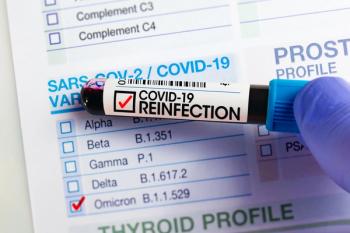
A Look at Antibiotics to Treat Pneumonia
This chart provides a simple way to answer questions that pharmacists will receive this winter.
Winter is almost here, and a typical phone call to the pharmacy will likely involve questions about antibiotics to treat pneumonia.
When doctors call, it is usually because the patient has multiple drug allergies and/or drug interactions that make antibiotic selection difficult. Based on Infectious Disease Society of America/American Thoracic Society guidelines, I have organized the information in a chart that makes sense to me.1-3 This chart is my sole creation, and I encourage others to formulate their own charts if they do not understand or like mine. I organized my chart from the least-aggressive drug regimen to the most aggressive.
The antibiotic choices are empiric treatment only. Once a bacterium is identified in the cultures, de-escalation occurs to avoid unnecessary adverse effects, costs, and possible drug resistance.
Normal Healthy Person
Macrolide
Doxy
Healthy person with asthma or other comorbidities
Amox, (or augmentin) plus macrolid (or doxy)
Quin (levo or moxi)
Patient sick enough to be admitted to hospital
Ceftriaxone (amp, cefotaxime)
Quin (levo or moxi)
Patient sick enough for the intensive care unit (ICU)
Ceftriaxone (or unasyn) plus azithromycin (or quin)
Pcn allergic aztreonam, plus quin
Patient sick enough for the ICU and high risk for methicillin-resistant staphylococcus (MRSA) and pseudo
Zosyn, (or cefepime, imipenem, meropenem) plus vanco (or linezolid)
The worst kind of pneumonia, high risk for multidrugresistant organisms (MDROs); late onset healthcare-associated pneumonia, hospital-acquired pneumonia, or ventilator-associated pneumonia (VAP)
Zosyn (or cefepime, imipenem, meropenem) plus vanco (or linezolid)--high risk for aggressive pseudo add quin, aminoglycoside plus azithromycin, or quin plus amino glycocie
What is significant for retail pharmacists is that the guidelines are for doxy or a macrolide but never both at the same time. If a prescription comes across for a z-pack and doxy, that would be a red flag to call the doctor.
Also, if the person is not getting better on augmentin, double check the dose. To treat serious cases of pneumonia, the guidelines are for a very high dose (2 grams, twice a day), not what one would typically think.
Also, the only oral antibiotic for pneumonia are the macrolids, doxy, the penicillins, and the quins.
Occasionally a doctor from the community will ask to prescribe bactrim. I say, of course you can, but it will only work if the bacterium is S. pneumoniae or staph. It unreliably and only sometimes covers H influenza, E. coli, klebsiella, and haemolytic strep. It never covers legionella, mycoplasma pneumoniaeo, or pseudomonas.
The most common bacteria that causes pneumonia are S. pneumoniae, H. influenzae, M. pneumoniae, and C. pneumoniae.
If the patient is not getting better on the first line of drugs, suspect legionella spp and drug-resistant streptococcus pneumoniae (DSRP). DRSP is resistant to macrolides and quins because of overuse of these antibiotics.
If the patient is still not getting better or is at high risk for an MDRO because of his or her lifestyle, then suspect P. aeruginosa, E. coli, klebsiella pneumoniae, acinetobacter spp, MRSA, or anaerobes that usually come from aspiration.
People at risk for MDRO are those living in nursing homes, prisons, other types of institutions, who frequently visit hospitals for dialysis, chemotherapy, wound care, or intravenous antibiotics, as well as anyone who has been admitted to the hospital in the past 90 days or those who have been in the hospital longer than 48 hours since the onset of symptom. If the stay in the hospital was less than 48 hours, it is most likely the less aggressive community-acquired pneumonia bacteria. Also, if the patient lives with a person who has an MDRO, they, too, are at risk of having it.
To simplify the chart, I did not include early-onset VAP. But it is good to know that it exists and one can de-escalate in that situation to less-aggressive antibiotics.
I also did not include aspiration pneumonia for people who have possibly inhaled their emesis or have swallowing difficulties and inhale saliva. Think about the bacteria in your mouth, stomach and intestines. Those bacteria include anaerobes that respond to moxi, levo, unasyn, clinda, or metronidazole.
Pneumonia caused by pseudomonas and acinetobacter requires 14 days minimum duration. Most pneumonias should be treated for 5 days and 7 days for asthma or other lung disease involvement. The patient must be clinically stable, with normal vital signs, oxygen saturation above 90%, no nausea or vomiting, and mentally alert.
If the doctor asks me questions that I am not comfortable answering, I refer them to an
Pneumonia is the eighth-leading cause of death in the United States. There is a 10% mortality rate in those who have community-acquired pneumonia and a 27% to 50% mortality rate for HAP.4 Choosing the right antibiotic to treat pneumonia is serious stuff.
References
1. Infectious Diseases Society of America. Community-acquired pneumonia (CAP).
2. American Thoracic Society. Guidelines for the management of adults with hospital-acquired, ventilator-acquired, and healthcare-associated pneumonia.
3. Kalil AC, Metersky ML, Klompas M, et al. Management of adults with hospital-acquired and ventilator-associated pneumonia: 2016 Clinical Practice Guidelines by the Infectious Diseases Society of America and the American Thoracic Society. Clin Infect Dis. 2016;63(5):e61-e111. doi: 10.1093/cid/ciw353.
4. Xu J, Murphy SL, Kochanek KD, Bastian BA. Deaths: final data for 2013. CDC.
Newsletter
Stay informed on drug updates, treatment guidelines, and pharmacy practice trends—subscribe to Pharmacy Times for weekly clinical insights.


















































































































































































































